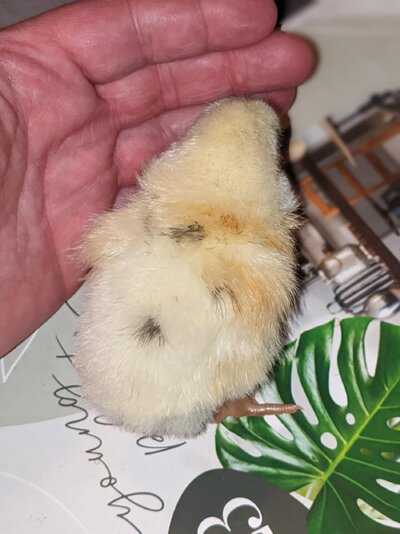RememberTheWay
Songster
- Apr 7, 2022
- 934
- 799
- 221
I have been experimenting with blue sex link crosses using Barred Plymouth Rock hens and a Splash Easter egger rooster. All of the resulting chicks have been blue and easily sex linked at hatch by the presence of lack of a white dot on the back of there heads.
A few wks ago one of my Barred rocks not being hatched from at the time got into my Ermine Breeding Pen when she followed me in and I just didn't remove her. Shortly afterwards (maybe a wk or two) she was removed from that pen and put in with the other barred rocks. I forgot about her being with the Ermine. I had a chick hatch a couple days ago clearly from a Barred rock egg (they are my only hens that lay that color brown) and the chick is Ermine colored. Yellow down with black spots. It has a straight or modified comb not sure yet.
I was wondering if someone could explain to me how this chick happened? I thought barring was dominant? But I also understand that if only the hen is Barred in a cross it won't be passed to her daughters? Does this mean this chick must be female? Is is possible to get a sex linkage from this cross?
A few wks ago one of my Barred rocks not being hatched from at the time got into my Ermine Breeding Pen when she followed me in and I just didn't remove her. Shortly afterwards (maybe a wk or two) she was removed from that pen and put in with the other barred rocks. I forgot about her being with the Ermine. I had a chick hatch a couple days ago clearly from a Barred rock egg (they are my only hens that lay that color brown) and the chick is Ermine colored. Yellow down with black spots. It has a straight or modified comb not sure yet.
I was wondering if someone could explain to me how this chick happened? I thought barring was dominant? But I also understand that if only the hen is Barred in a cross it won't be passed to her daughters? Does this mean this chick must be female? Is is possible to get a sex linkage from this cross?
Attachments
-
 Messenger_creation_7ec0bb99-3211-4b27-b34e-eebd36472dd6.jpeg252.1 KB · Views: 38
Messenger_creation_7ec0bb99-3211-4b27-b34e-eebd36472dd6.jpeg252.1 KB · Views: 38 -
 Messenger_creation_53aea819-9fdd-4f25-ac4a-202c698339ec.jpeg233.6 KB · Views: 11
Messenger_creation_53aea819-9fdd-4f25-ac4a-202c698339ec.jpeg233.6 KB · Views: 11 -
 Messenger_creation_6fa507ae-6baa-4870-bfec-8c4f9fceb350.jpeg279.4 KB · Views: 6
Messenger_creation_6fa507ae-6baa-4870-bfec-8c4f9fceb350.jpeg279.4 KB · Views: 6 -
 Messenger_creation_d141911e-3988-4b4f-8cfd-d99c3c3422fa.jpeg315.7 KB · Views: 7
Messenger_creation_d141911e-3988-4b4f-8cfd-d99c3c3422fa.jpeg315.7 KB · Views: 7 -
 Messenger_creation_5d2da4ea-d688-43c0-839c-0c6ffe3af3b3.jpeg288.7 KB · Views: 8
Messenger_creation_5d2da4ea-d688-43c0-839c-0c6ffe3af3b3.jpeg288.7 KB · Views: 8 -
 Messenger_creation_33938292-7861-4fd6-a1f5-4ebf97e7bc58.jpeg160 KB · Views: 8
Messenger_creation_33938292-7861-4fd6-a1f5-4ebf97e7bc58.jpeg160 KB · Views: 8 -
 Messenger_creation_0a84d515-21ce-4d65-9f42-bc90a4e11079.jpeg271.5 KB · Views: 7
Messenger_creation_0a84d515-21ce-4d65-9f42-bc90a4e11079.jpeg271.5 KB · Views: 7 -
 Messenger_creation_4f8acabd-a2bf-49da-b9b3-760d7d3ad97f.jpeg290.5 KB · Views: 4
Messenger_creation_4f8acabd-a2bf-49da-b9b3-760d7d3ad97f.jpeg290.5 KB · Views: 4 -
 Messenger_creation_2696783a-dd52-42af-8d8b-25c9f2d7f892.jpeg277.7 KB · Views: 13
Messenger_creation_2696783a-dd52-42af-8d8b-25c9f2d7f892.jpeg277.7 KB · Views: 13





